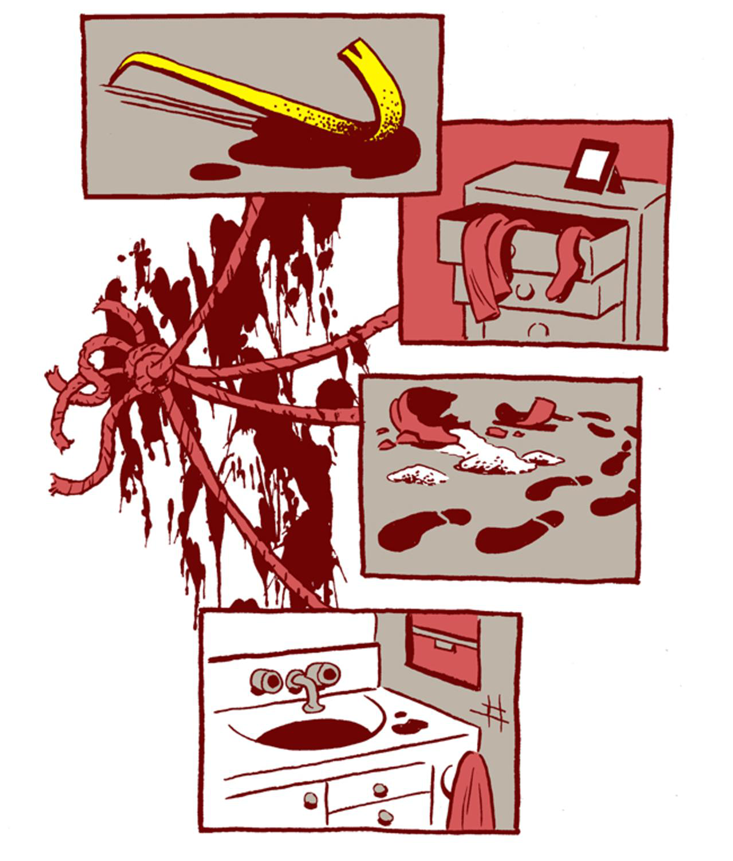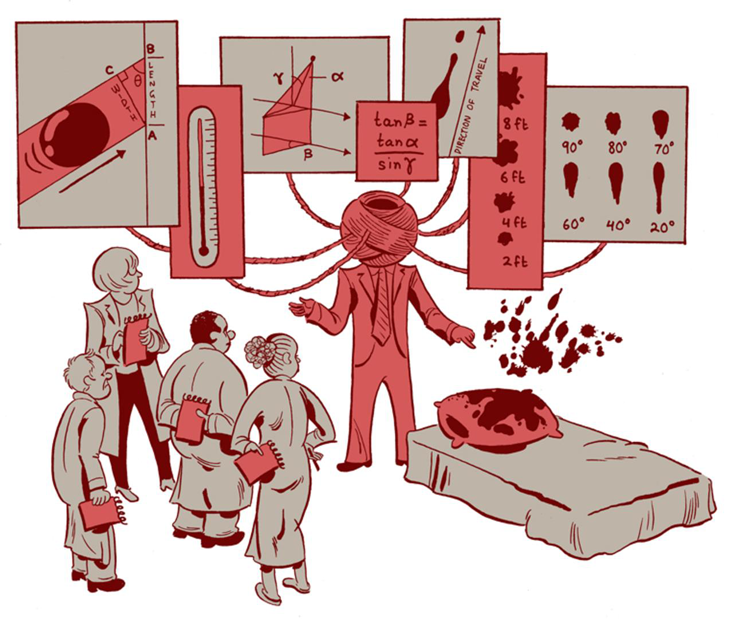What will drop the blood: trigonometry of crimes
- Transfer
How is forensic science developing, studying drop of blood [ reading is not for the faint of heart ]

By the time Donald Johnson was called and asked to appear at the crime scene, the victim had been dead for hours. The first who appeared at the crime scene, opening the door of the apartment, found a woman lying on the edge of the bed, naked from the waist down and lower, connected with her mouth sealed with adhesive tape. She was beaten to death. Slaughterhouse detectives needed an expert to assemble evidence. This is what Johnson did.
Johnson, who then worked as chief criminalist for the Los Angeles Department of the District Sheriff, studied the apartment. On the kitchen floor lay fragments of ceramics — the remains of a can in which flour was stored. Johnson drew attention to two sets of traces in flour, which indicated that there were two attackers. The clothes that were taken from the chest were scattered against the wall opposite the bed. Judging by the hacked lock, Johnson was able to understand that the lock was opened by force, possibly mount. There was blood on the lock too, and a trail of drops led to the sink, where the attacker washed his hands.
There was enough blood for Johnson to compile a complete DNA profile.
This terrible crime happened 28 years ago, but the whole scene is reproduced in the classroom of the Hertzberg-Davis Center for Forensic Sciences at the University of California at Los Angeles, where Johnson, 60, has been working as an adjunct professor of criminology since 2003. He is currently working on a new forensic technology, the “spray source determination system”, to improve the crime detection method through a blood test.

The Center for Forensic Science works not only for students, but also for the Forensic Science Laboratory of the Los Angeles Police Department and the Department of District Sheriff. It is the largest laboratory in the district, and in size it is second only to that owned by the FBI. The center carries out not only the analysis of blood spatter, but also the analysis of DNA, controversial documents, drugs, various traces, ballistic tests. For educational purposes, Johnson often reproduces real crime scenes, which he worked as a criminalist until he left this area in 2003. For this scene, he used a dummy and sterilized pig blood.
“You know, there are such hospitals where people are trained,” says Johnson. - And here we are - an educational laboratory. But Johnson is not a fictional character likeGila Grissom or Dexter Morgan . He is real. He has graying hair with a parting on the side, a kind and hard look, fringed with wrinkles, and a constant hint of a smile. He looks like a mix of Mark Hermon and Mr. Rogers. He speaks slowly and clearly, often touching his chin with his hand, and wears a little Sherlock Holmes badge on his jacket. On the wall of his office hangs a stuffed bat, a tribute to his love for these animals since childhood, and outside on the door - a poster with Batman. He also keeps the skin of a 30-year-old python - a gift he received from another forensic scientist after an autopsy carried out by them showed that the rat stuck in his intestines was the cause of the python's death. A motorcycle helmet and a cup for the first place in the aerobatic competition are located on the cabinet with documents, since when he flew airplanes - they speak both to his love of life and to the extreme accuracy necessary to control both types of transport. And, naturally, the whole wall is filled with forensic books.
Johnson began his career as a drug chemist at the Los Angeles Sheriff's District Department. He was trained on the discovery of drugs such as cocaine and methamphetamine made in illegal laboratories. But he always wanted to work in the violent crime department. Death and murder investigations “I have always found it interesting and intriguing,” he says. As a child, he was interested in biology, and recalls how he was doing homework for the third grade, which his mother found and sent to him when he got to the sheriff's department. The caption read: “If you could make three wishes, what would you like?”
“I wanted a robot, a helicopter and a crime lab in my bedroom,” he says. Johnson worked as a necropsy technician in the Coroner's department of Lukas County, while studying at Ohio Medical College in Toledo, in his hometown. He then moved to Los Angeles to study biology at the University of California, Los Angeles. To provide for himself during his studies, he worked as an undertaker. He then entered Los Angeles Medical School, and worked in the Los Angeles County Coroner Department.
His passion for biology has teamed up with a growing enthusiasm for justice. Since 1989, Johnson has dedicated his professional life to forensic science and its application to law enforcement. When he began to work, the possibilities of analyzing blood and DNA were limited. Now criminologists can get a DNA profile by a drop of blood of a few millimeters.
For forensic scientists, the analysis of blood spatters — such as those appearing next to the body of a man beaten to death — has long been a tool for solving crimes. Depending on the size and shape of the droplets, researchers can often tell which weapon caused these splashes, determine approximately where the attack occurred, and track the victim’s position.
Flying drops of blood usually take the form of a ball, and when they hit, say, a wall, they take the form of an ellipse, with a tail pointing in the direction of movement. First, forensic scientists determine the angle of impact of drops, using a complex mathematical formula. Then, after a sufficient number of measurements, they determine the area of the source, tracking blood drops back, marking their path, using threads, marking up a complex network. When the threads begin to intersect, they show the approximate area where the attack occurred.
“Often a blood test is used to test an alibi, such as self-defense,” says Johnson. “Often it is used to recreate the events related to the crime, which helps to understand the case in detail.”
Suppose a criminalist investigates a potential murder case involving a head injury to a victim with a blunt object , and the defendant claims that he was attacked and hit the victim in self-defense. How to check this statement?
Blood spatter analysis can help answer the following questions: where was the victim's head at the time of the impact? Was she a meter or two meters from the floor, and how far was she from the wall? If the blows were struck closer to the floor, say, in the area of the bed, or when the victim was sitting on something, then it would be more difficult for the accused to prove the fact of self-defense.
This method of analyzing blood splashes requires obtaining multiple photos of the crime scene, which then have to be enlarged in order to make measurements. All measurements are done manually, and the calculations - on the calculator, so there is always room for errors. Also, evidence in the form of blood can become contaminated when criminologists work with them with their hands. That is why Johnson and his team created a more sophisticated and effective blood spatter analysis system.

Together with David Raymond, a specialist in forensic biomechanics and experimental mechanics, as well as graduate engineering engineers Angela Wu, Jose Rodriguez and Kevin Tepas, Johnson and the team are trying to revolutionize the field analysis of blood spatter. Current methods of blood stain analysis can give researchers only approximate data on the angle of spray falling, since “problems associated with the ballistic droplet pathway prevent us from taking the measured angle for absolutely accurate,” as written in the book “Analysis of blood stains” by forensic authors Tom Bevel and Ross Gardner. "As a rule, the error of the angles of incidence of droplets is assumed to be 5-7 degrees." Modern trigonometric models do not take into account air resistance, gravity and room temperature, defining the flight path of the drop - they suggest moving the drops in a straight line. Johnson and his team are looking for an improved mathematical model that can take into consideration all such variables.
Graduate students spent the entire fall of 2013 studying the current methods of blood stain analysis. In 2014, they worked on a prototype imaging system capable of simulating all conditions from the crime scene and producing more accurate measurements of blood stains and droplet collision angles, converting pixels of a digital photo of blood into centimeters. This process should save all those long hours spent on manual pulling threads.
The system for establishing the source of the spray is still in an embryonic state. The goal is to develop a portable device or tablet program that can be issued for use in the field, first by the Los Angeles police and the sheriff’s investigators, and then to all criminologists.
“Los Angeles is the center, it’s the main forensic unit,” says Raymond. “When other criminologists start learning about what we are doing, I think this trend will spread everywhere.”
As a result, in addition to the fact that the data obtained by measuring blood stains from digital images will be much more accurate than after measuring the stains with a ruler, they claim that their technology will even be able to determine the area that served as the source of blood spatter in three-dimensional space and report immediately on the made photo.
Johnson worked on one of his last affairs in 2001. A family was killed, including an 8-year-old girl and her 79-year-old grandmother. In addition, the killers still sexually outraged the girl. Johnson was invited to speak at the court hearing as a forensic expert in charge of this case. The meeting was attended by other family members of the victims. Johnson will never forget the moment he was asked about sexual abuse.
“When I said that I had discovered semen in vaginal and rectal tests, the family gave this horrible moan. Everyone in court froze, silence hung over the room, says Johnson. “And only that agonizing moan was heard.”
The only thing that could comfort Johnson a bit was that he managed to bring all the criminalistic information necessary for the triumph of justice to the court. This approach helps many forensic experts to cope with the particularly cruel nature of their work.
“We can say that I have a special gift to help people and society,” says Johnson. “However, you should always keep your distance.” This is similar to the work of a doctor. It is necessary to be interested in the patient, but not to get involved in them. ”
However, it is not so easy to do. Seeing the child who was raped and killed, Johnson thought about other ways to help the victims. The work of the criminologist is mostly reactionary, he says. The crime has already happened, after which the criminologist responds to it. This was one of the motivations that forced Johnson to retire from field work and take up full-time teaching work.
“I decided that by teaching people I can help others,” he says, “and they, in turn, will be able to help the victims.”
